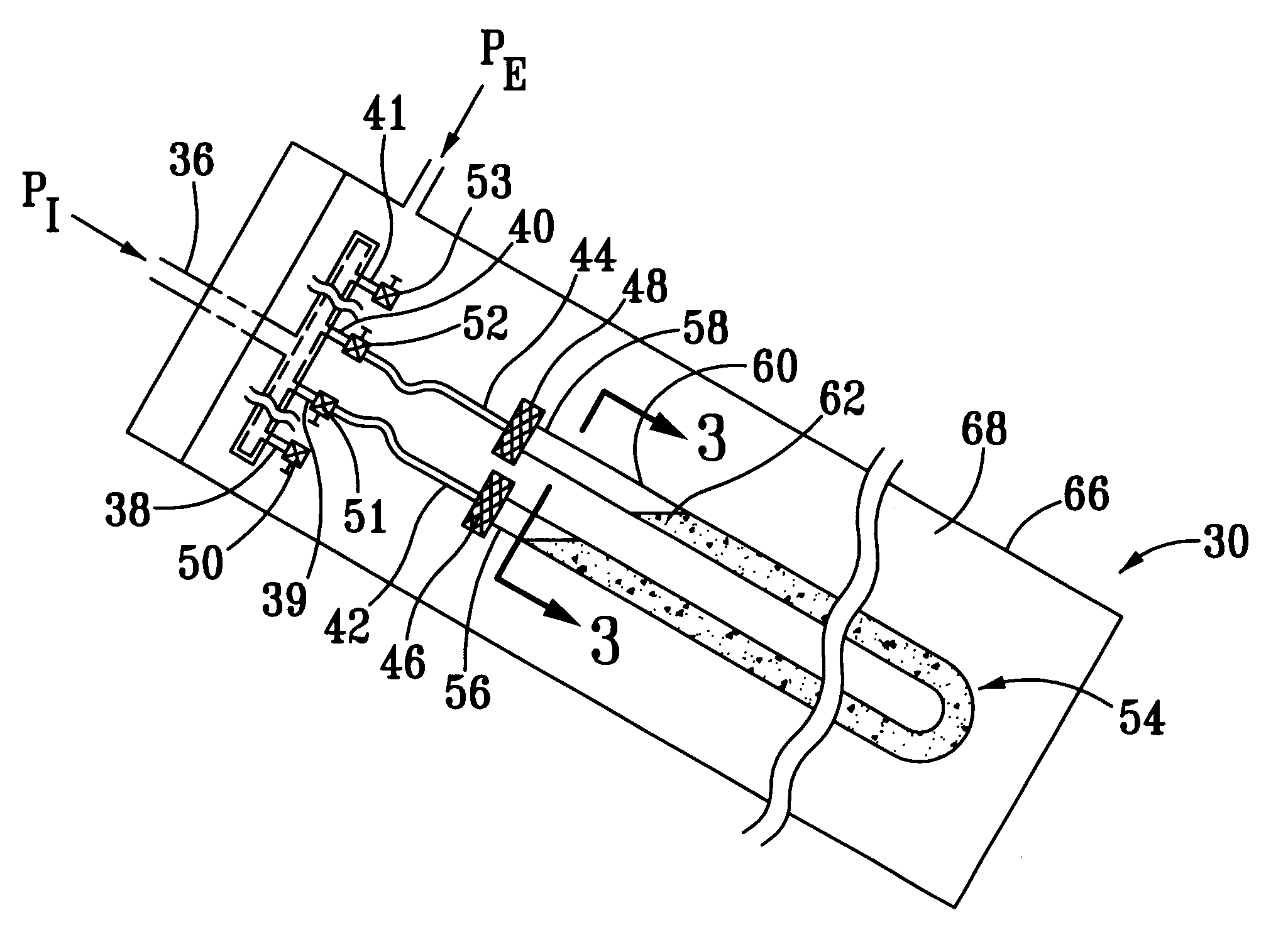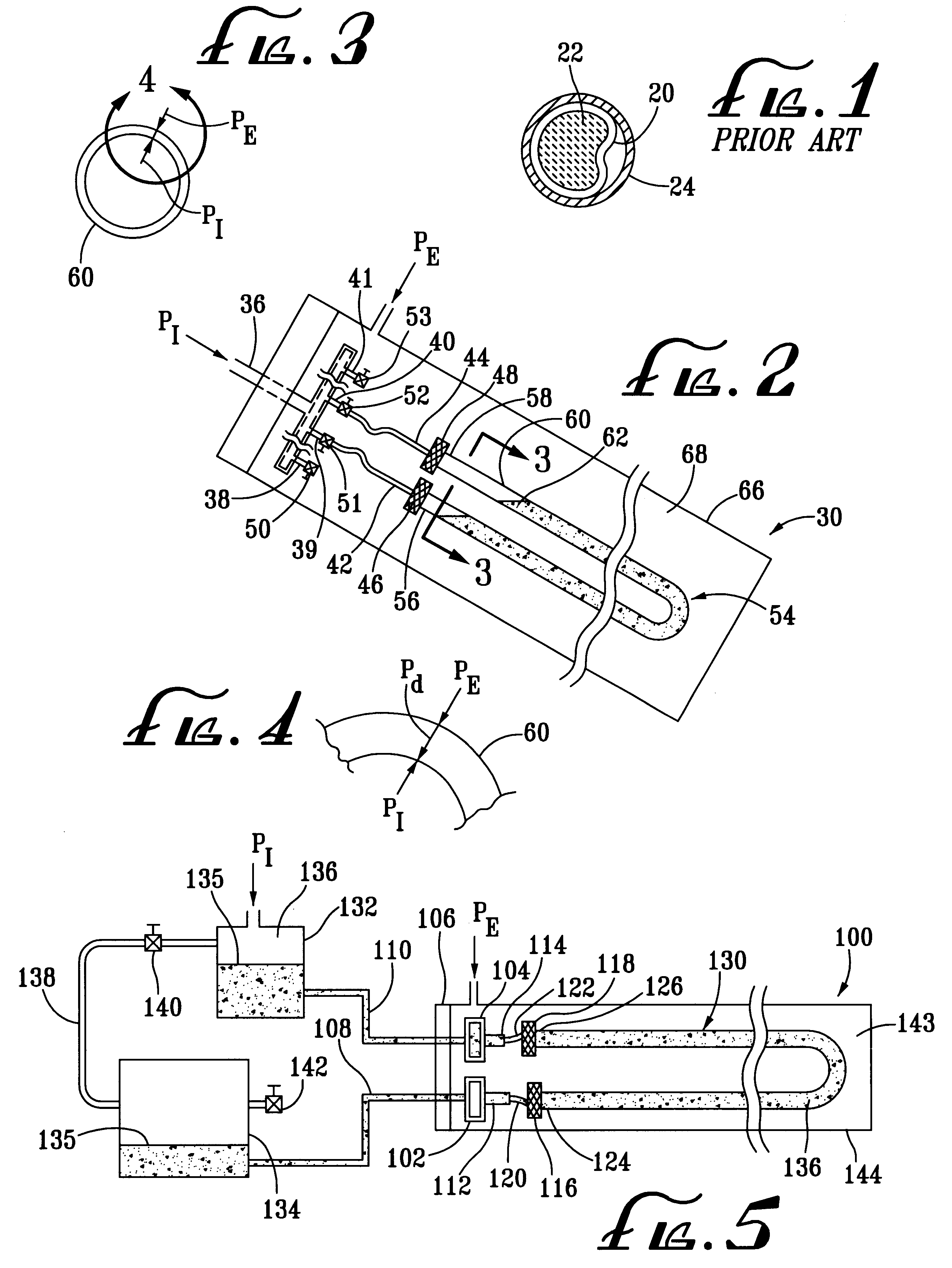Optical fibers and processes and apparatus for making the same
- Summary
- Abstract
- Description
- Claims
- Application Information
AI Technical Summary
Benefits of technology
Problems solved by technology
Method used
Image
Examples
first embodiment
In a first embodiment, a reactor 30 as set forth in U.S. Pat. No. 5,122,580 is modified as shown in the diagram of FIG. 2. The closing hatch 32 of the reactor is fitted with a manifold 34 having an inlet tube 36 and outlet tubes 38-41, tubing extensions 42 and 44, conventional compression fittings 46 and 48 and conventional valves 50-53 on the outlet tubes, and for connection to the open ends of one or more cladding assemblies 54 with any suitable, conventional means. Only one cladding assembly 54 is illustrated in FIG. 2. The fittings 46 and 48, tubing extensions 42 an 44 and valves 51 and 52 connect the open ends 56 and 58 of the cladding assembly 54 including a cladding 60 filled with a monomer mixture 62 through the outlet tubes 39 and 40 of the manifold 34. The manifold 34 provides a passageway between the cladding ends 56 and 58 and the inlet tube 36. The inlet tube 36 connects to a conventional pressure source (not shown), preferably, comprising an inert gas, such as nitrogen...
second embodiment
a reactor 100 as illustrated by FIG. 5 utilizes the full length of the cladding(s). During the polymerization reaction, 10-15% of the volume of the monomer mixture is lost. For instance, typically, a 35 m length of cladding is used to obtain a final optic length of 30 m. The unused 5 m of the cladding is thereafter discarded. It is desirable to prevent the loss of cladding material. With reference to FIG. 5, two manifolds 102 and 104 are attached to the hatch 106, each having an inlet tube 108 and 110 and outlet tubes 112 and 114. The outlet tubes 112 and 114 connect through fittings 116 and 118 and tubing extensions 120 and 122 to respective ends 124 and 126 of a cladding assembly 130. Two exterior tanks 132 and 134 connect to the inlet tubes 108 and 110 of the manifolds 102 and 104. A first or inlet tank 132 is large enough to contain the monomer mixture 135 needed for the reaction. A second or outlet tank 134 is large enough to hold any excess mixture 135. Once the cladding assem...
example 1
An FEP Teflon.RTM. cladding with a an inside diameter (ID) of approximate 11 mm and a wall thickness of 0.51 mm was heat expanded to an approximate internal diameter of 12 mm and wall of 0.46 mm and jacketed with a manufacturing jacket made of poly(ethylene) having an approximate wall thickness of 1.8 mm. A 35 m length of this cladding and manufacturing jacket combination was filled with a monomer mixture of approximately 50 parts by volume of highly purified (distilled under vacuum) methyl methacrylate, 50 parts by volume of CR-39 manufactured by PPG, Ind. of Pittsburgh, Pa. and initiated with 0.6 parts by volume of isopropyl peroxide. The cladding filled with the monomer mixture was formed into a U shape and placed inside a reactor as described in U.S. Pat. No. 5,225,166. The reactor was modified to the first embodiment as illustrated by FIG. 2 herein. The cladding assembly was attached using fittings of the compression fitting type manufactured by Swagelock.RTM. of Solon, Ohio.
Th...
PUM
| Property | Measurement | Unit |
|---|---|---|
| Area | aaaaa | aaaaa |
| Area | aaaaa | aaaaa |
| Area | aaaaa | aaaaa |
Abstract
Description
Claims
Application Information
 Login to View More
Login to View More - R&D
- Intellectual Property
- Life Sciences
- Materials
- Tech Scout
- Unparalleled Data Quality
- Higher Quality Content
- 60% Fewer Hallucinations
Browse by: Latest US Patents, China's latest patents, Technical Efficacy Thesaurus, Application Domain, Technology Topic, Popular Technical Reports.
© 2025 PatSnap. All rights reserved.Legal|Privacy policy|Modern Slavery Act Transparency Statement|Sitemap|About US| Contact US: help@patsnap.com


